More birds are nesting in our gardens than ever before. If you’re lucky enough to have any bird nests in your garden, here’s how you can learn who lives where.
With spring here, watch out for birds carrying nesting material – you may even wish to provide nesting material for them. If you're able to, put up a garden bird nestbox, and if you're feeling crafty, try making a bird nestbox. Learn how to attract a variety of wildlife species to your garden in our wildlife gardening hub.
Wild birds' nests and eggs are protected by the law. It is an offence to disturb nesting birds, to take or sell wild birds’ eggs, – it is an offence under the Wildlife & Countryside Act 1981, and a licence is needed for photography.
Illustrations by David Daly or Felicity Rose Cole.
You may also like:
Finding and identifying empty bird and mammal nests
Autumn and winter are a great time for finding and identifying empty birds' and mammals' nests as deciduous trees and bushes lose their leaves, says naturalist and presenter Brett Westwood:
A season of nest-building, egg-laying and infant-rearing activity is laid bare in autumn and winter. Falling leaves and shrivelling grasses reveal the edifices of a bustling spring and summer that have long been confined to history. Like detectives, we can read the clues amidst the stark landscape, and piece together the success of our local birds and mammals by searching for their deserted nests.
It’s eyes to the ground first, where the neat, round, tennis-ball-sized nests of harvest mice are built in bramble thickets and scrub. Old carpets, corrugated iron panels and discarded timber hide the grass homes of field voles. In thickets of gorse and hawthorn, long-tailed tits construct their flask-shaped nests from as many as 3,000 feathers interlaced with animal hairs and flakes of lichen. These sturdy constructions should survive the winter, though, like the wren’s similar nests of moss and leaves, they will not be used again.
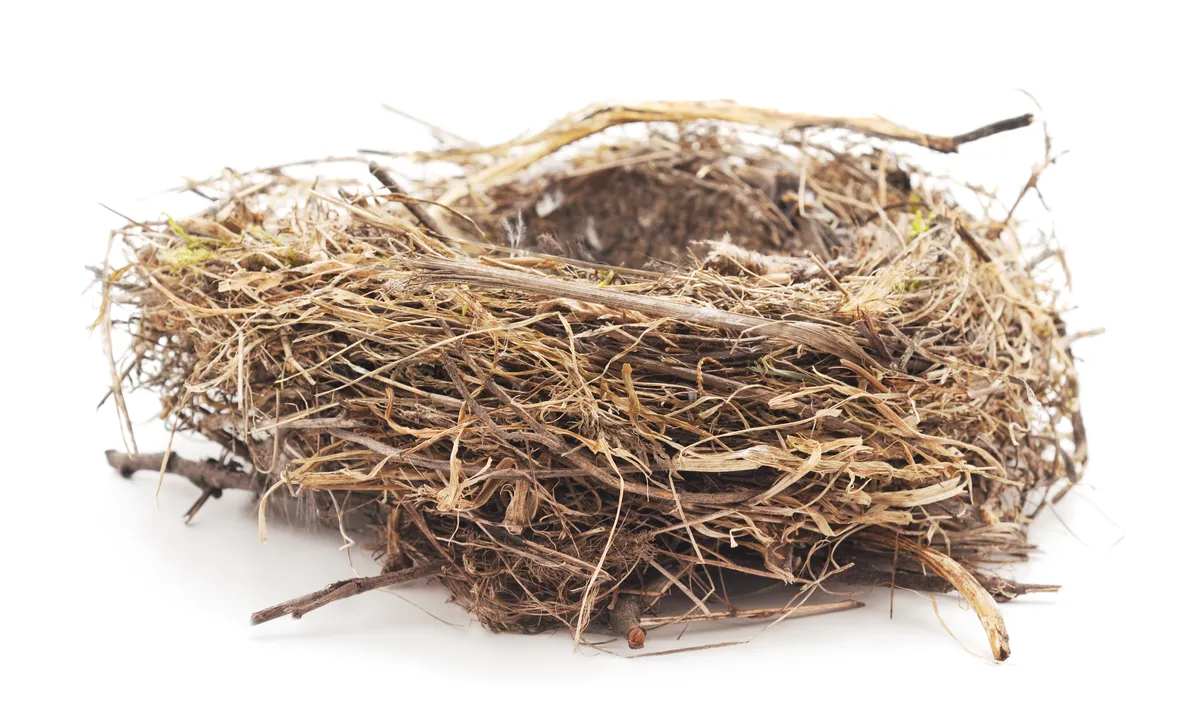
As the foliage of deciduous trees falls, the minimalist platforms built by woodpigeons, so flimsy and half-hearted that you can often see the eggs through the base, are exposed. Slightly higher and often in quite small urban trees are the twiggy cages of magpies, with their characteristic arch of sticks overtopping the main nest.
In the fork of large trees, grey squirrel dreys are common, while at the very top, still holding tight in autumn squalls, are the beautifully laid constructions of rooks, twigs interwoven skilfully to provide stability in even the fiercest gale.
It is illegal to take, disturb or destroy the nest of any bird species whilst it is being built, or in use, or to take or destroy birds’ eggs. It is often recommended to leave even empty nests alone, since they may be reused the next year, for roosting in other winter, or other animals may find them useful.
How do small birds clean their nests?
Most passerines sanitise their nests, which explains why chicks typically produce their faeces within a tough mucous membrane known as a faecal sac that makes it easier for the adults to carry the waste away, though sometimes they swallow the sac instead.
Since the chicks require a warm and dry environment, removing the faeces benefits both hygiene and insulation; it may also reduce the visibility of the nest to predators.
Most passerine species remove the chicks’ droppings throughout the breeding attempt, but a few – notably finches – stop when they are a week or so old. As a result droppings build up around the rim of the nest, where most large chicks tend to defecate. This provides a useful guide to those monitoring finch populations, because it indicates whether the nest survived through to the chick stage or not.
This Q&A originally appeared in BBC Wildlife, and was answered by Mike Toms from the British Trust for Ornithology (BTO).
How to identify bird nests
European greenfinch nest (Chloris chloris)
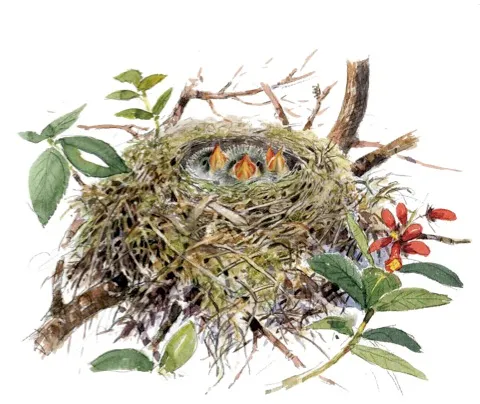
Greenfinch nests have an untidy appearance, and are made of dried grass, moss and thin twigs, lined with hair, thin roots and sometimes feathers, with a nest cup size of 6.5cm. They are located in bushes or low trees between 1.5-5m high, usually just inside canopy; sometimes deeper, and nests may be in small groups.
Greenfinches have two broods, occasionally three, between April and July.
The greenfinch's scientific name, Chloris chloris, is an example of a tautonym, where the genus and specific name are the same.
Common chaffinch nest (Fringilla coelebs)
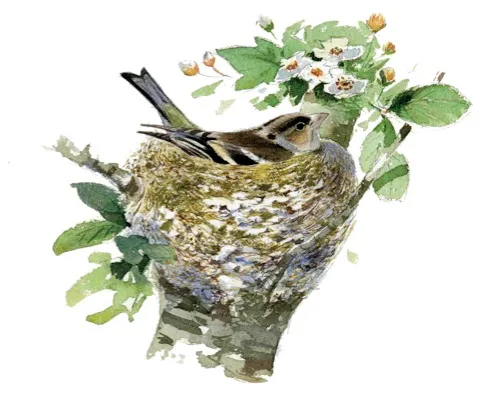
Chaffinch nests are one of the neatest nests of any bird, and is made of carefully woven moss, and decorated externally with lichens and cobwebs and lined with hair, with a nest cup size of 6cm. Like the greenfinch nest, the chaffinch nest is usually located in bushes or low trees between 1.5-5m high, usually just inside canopy; sometimes deeper.
Chaffinches typically have two broods, occasionally three, between April to July.
European goldfinch nest (Carduelis carduelis)
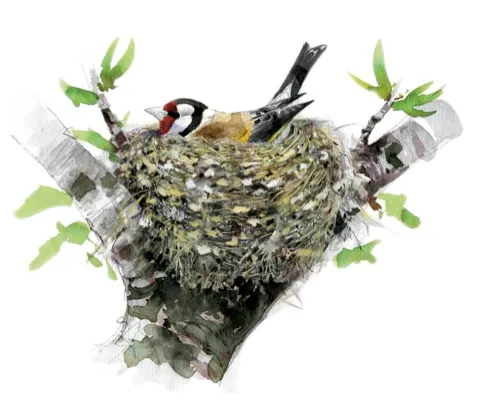
Goldfinch nests are a very neat cup of moss lined with thistle-down and wool, with a nest cup size of 6cm. Like the greenfinch and chaffinch nests, the goldfinch nest is usually located in bushes or low trees between 1.5-5m high, usually just inside canopy; sometimes deeper.
Goldfinches have two broods, occasionally three, between April and July.
The goldfinch's scientific name, Carduelis carduelis, is an example of a tautonym, where the genus and specific name are the same.
Dunnock nest (Prunella modularis)
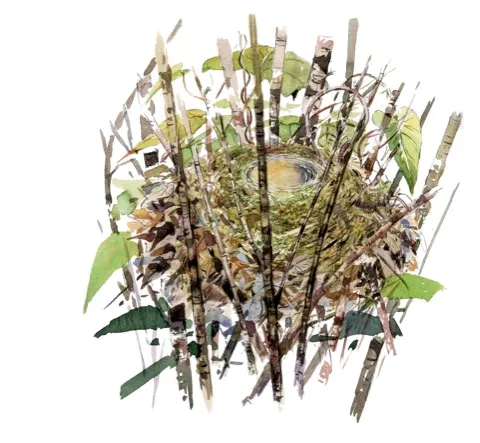
The main structure of a dunnock nest is moss mixed with leaves and lined with moss, wool, hair and feathers. It has a small, relatively flat nest cup of 6cm, with a foundation of twigs. Dunnocks normally nest in bushes, usually with dense cover, tangles of sticks and dense vegetation; and often close to ground, rarely higher than 1.5m.
Dunnocks have two broods, occasionally three, between March and July.
European robin nest (Erithacus rubecula)
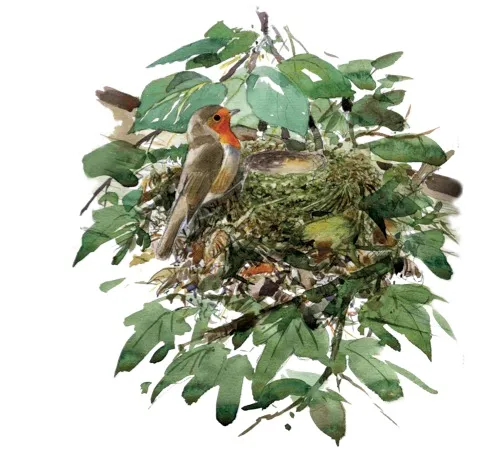
A robin's nest is made of moss on a foundation of dead leaves, and lined with hair or rootlets, with a nest cup size of 7cm. The nests are typically well hidden under ivy, among tree roots, under thick herbage or ledges of buildings, or in outhouses. They are rarely higher than 3m and usually close to the ground.
Robins have two broods, sometimes three, between March and June.
Long-tailed tit nest (Aegithalos caudatus)
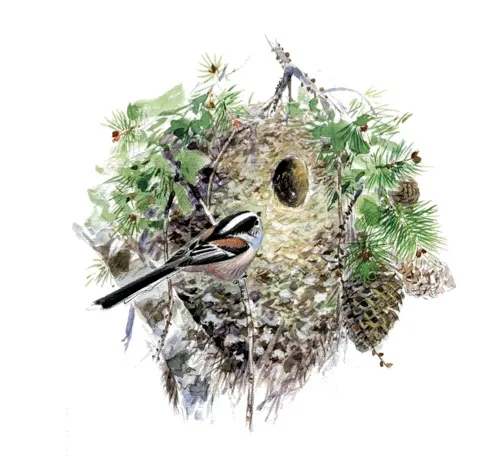
The nest of a long-tailed tit is an interwoven oval ball of lichen, moss, cobwebs, up to 2,000 feathers and hair. There is a hole in one side, usually near the top. The nest is often in gorse or brambles between 1 and 5metres high, or in coniferous or deciduous trees up to 20m high, usually in forks or at the ends of branches.
Long-tailed tits have just one brood, between March and May.
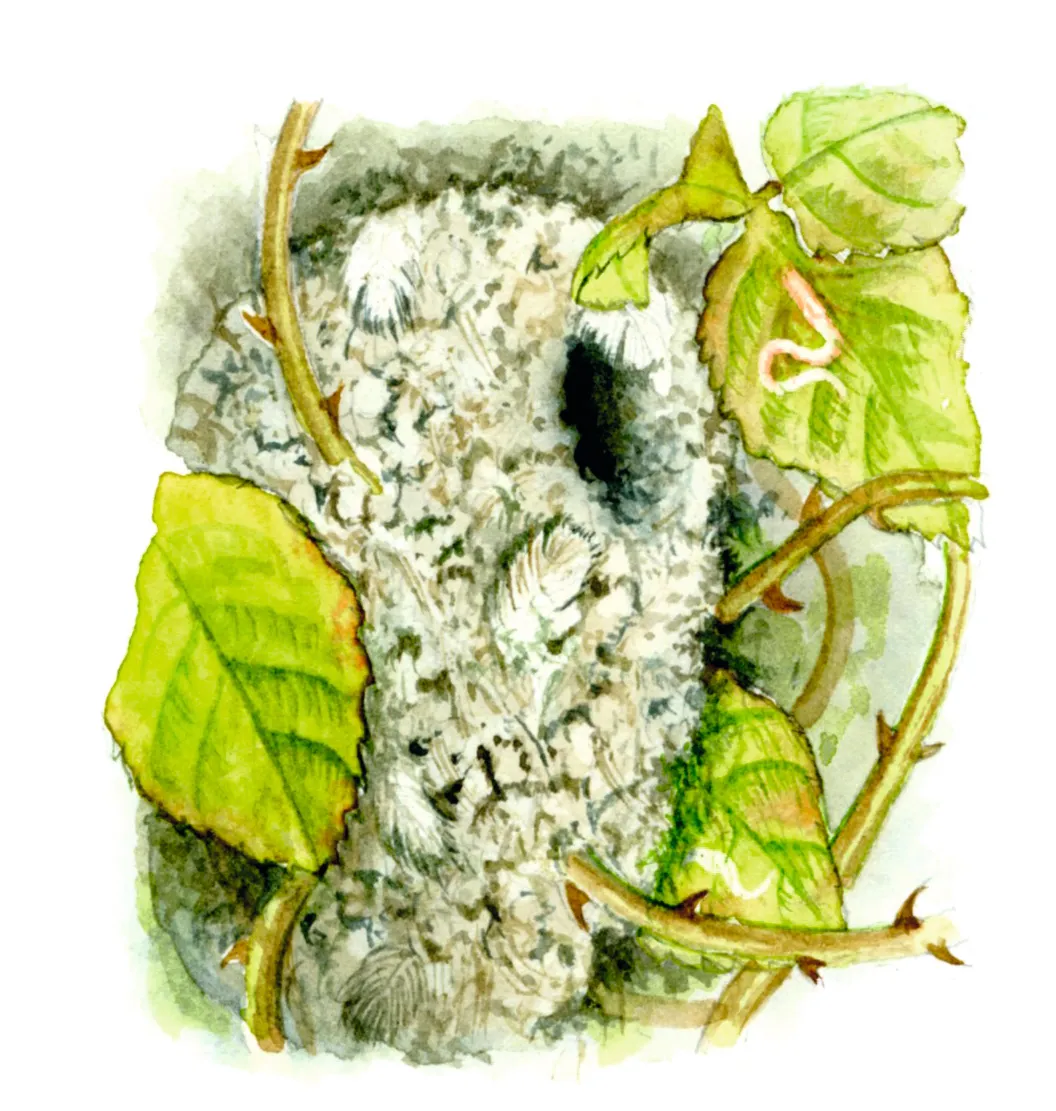
Wren (Troglodytes troglodytes)
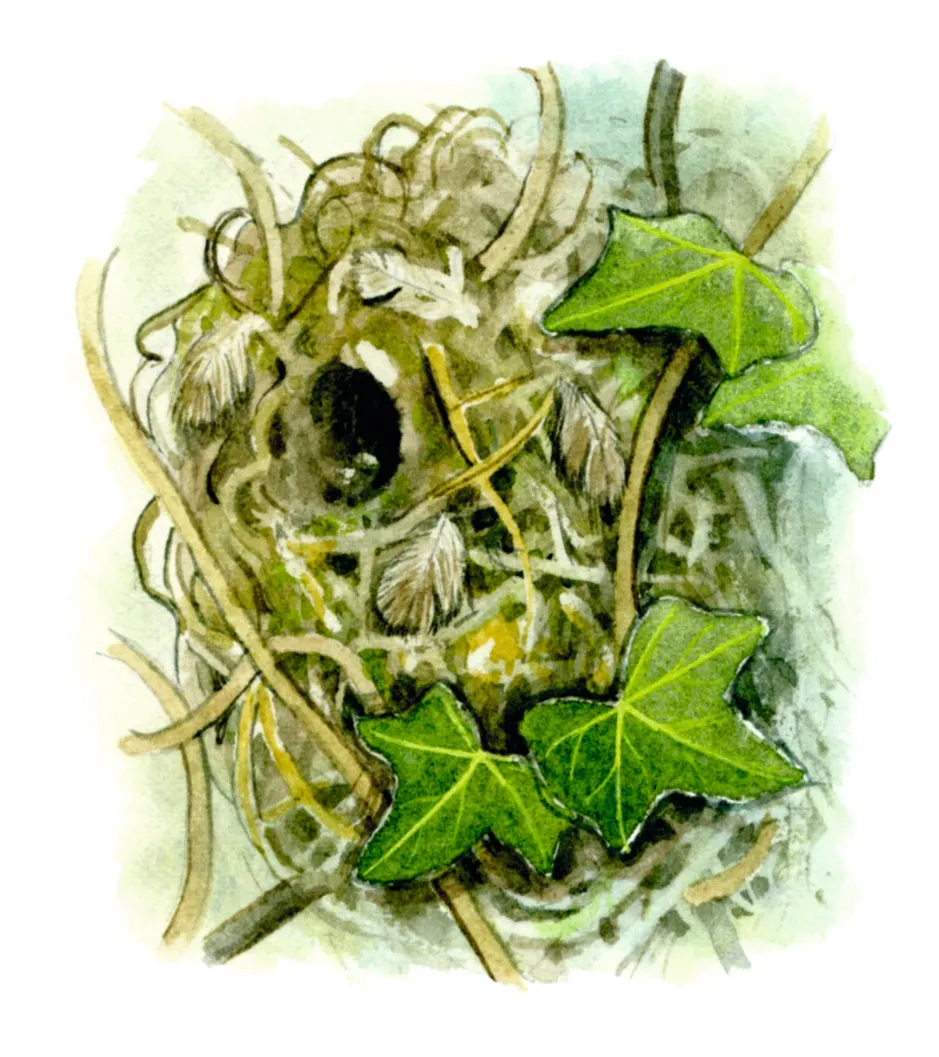
A wren's nest is a neat ball of leaves, moss, grass and other plant material and lined with feathers, located in shrubs and or within hollows or cavities up to 3m high. The male builds the main structure for several nests, and if successful in attracting a mate, the female chooses one and lines it. There is a distinct entrance hole in the side, often overhung and less than 2.5cm in diameter, and the lower lip of the hole is reinforced with grass and fibres.
The breeding season begins in April, with two broods.
The wren's scientific name, Troglodytes troglodytes, is an example of a tautonym, where the genus and specific name are the same.
House sparrow nest (Passer domesticus)
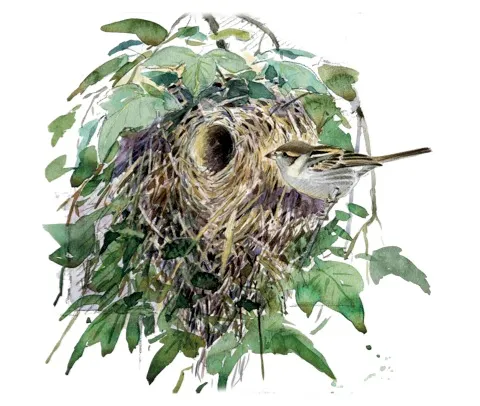
A house sparrow nest is an untidy dome of grass or straw, lined with feathers and built by both sexes. Nests can be variable in size, but in cavities the nest is much reduced. Nests are usually located in trees or bushes up to 20m high, but generally around roof height, and often in cavities in walls and buildings; usually in colonies.
House sparrows have two or three broods, rarely four, between February to August.
Common blackbird nest (Turdus merula)
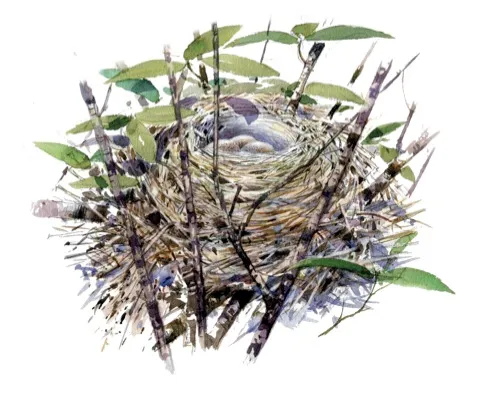
The nest of a blackbird consists of a cup of dried grass, moss and feathers lined with mud, often in bushes or hedges up to 3metres high, but occasionally much higher in trees or on ledges of buildings. The nest is bulky and conspicuous in appearance, with a nest cup size of 9cm.
Blackbirds have two broods, sometimes three, between March and July.
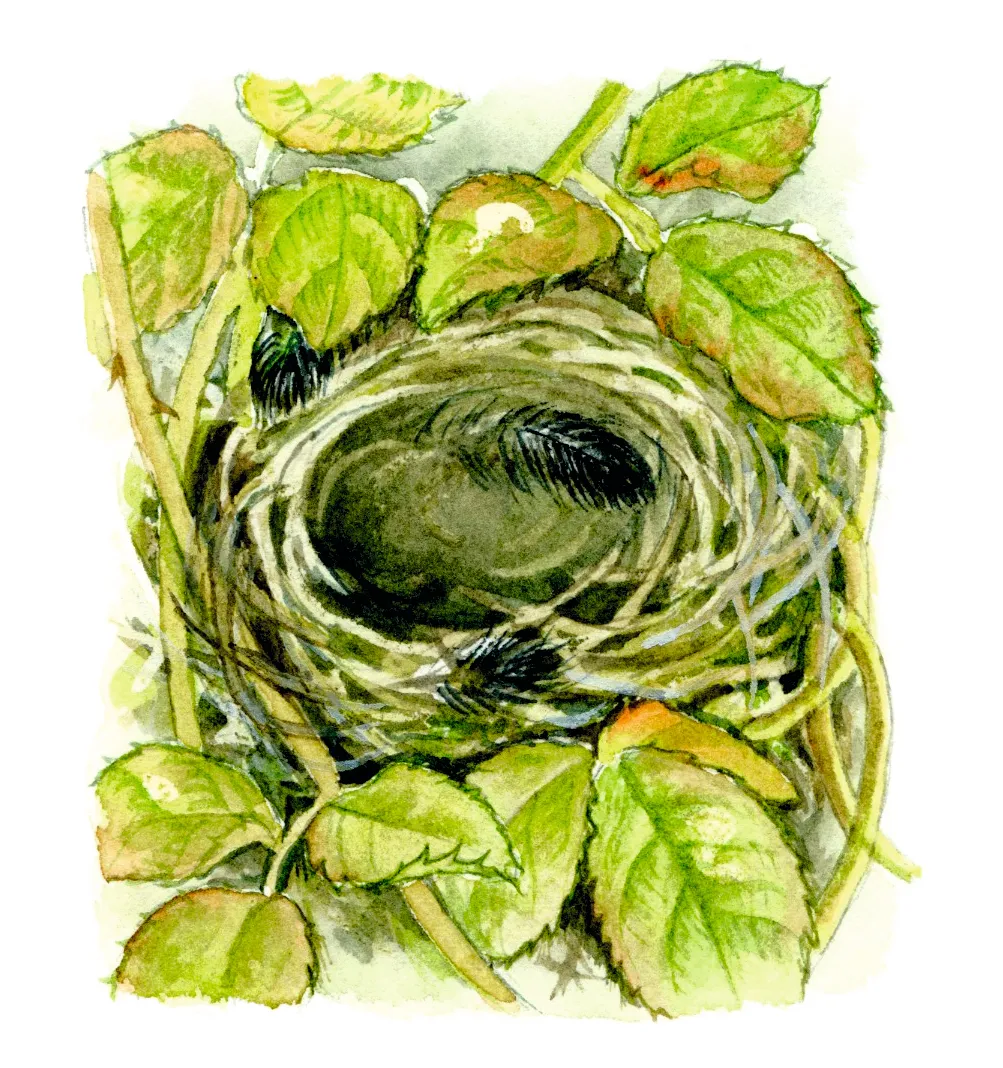
Song thrush nest (Turdus philomelos)
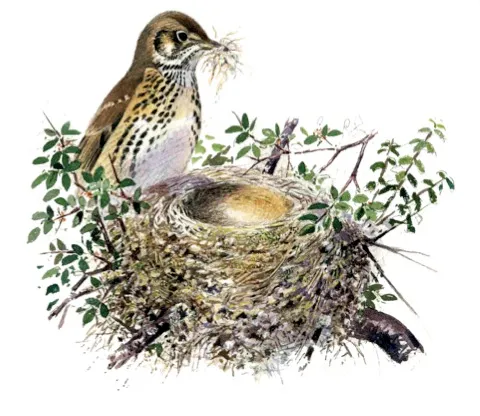
Like the blackbird’s nest, but the song thrush nest is unique among British bird nests in having a hard lining of mud, rotten wood and dung, cemented with saliva and moulded into shape by the female’s breast, with a nest cup size of 9cm. Similar location to blackbird nests, often in bushes or hedges up to 3metres high, but occasionally much higher in trees or on ledges of buildings.
Song thrushes have two broods, occasionally three, between March and July.
Mistle thrush nest (Turdus viscivorus)
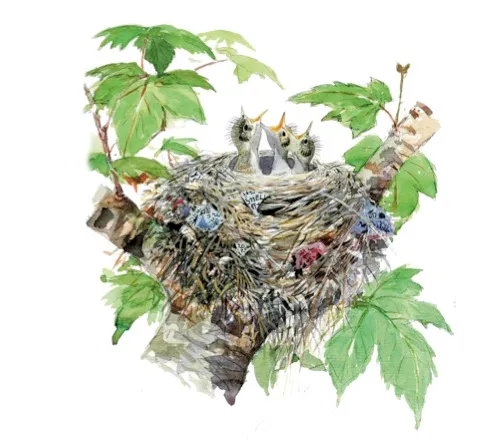
A mistle thrush nest is a mud-lined weave of dried grass and moss, decorated with flowers, green leaves, paper or other rubbish. A nest is bulky and conspicuous, with a nest cup size of 10cm and usually located in tree forks close to trunk and generally high up in the tree.
Mistle thrushes have two broods, occasionally three between March and July.
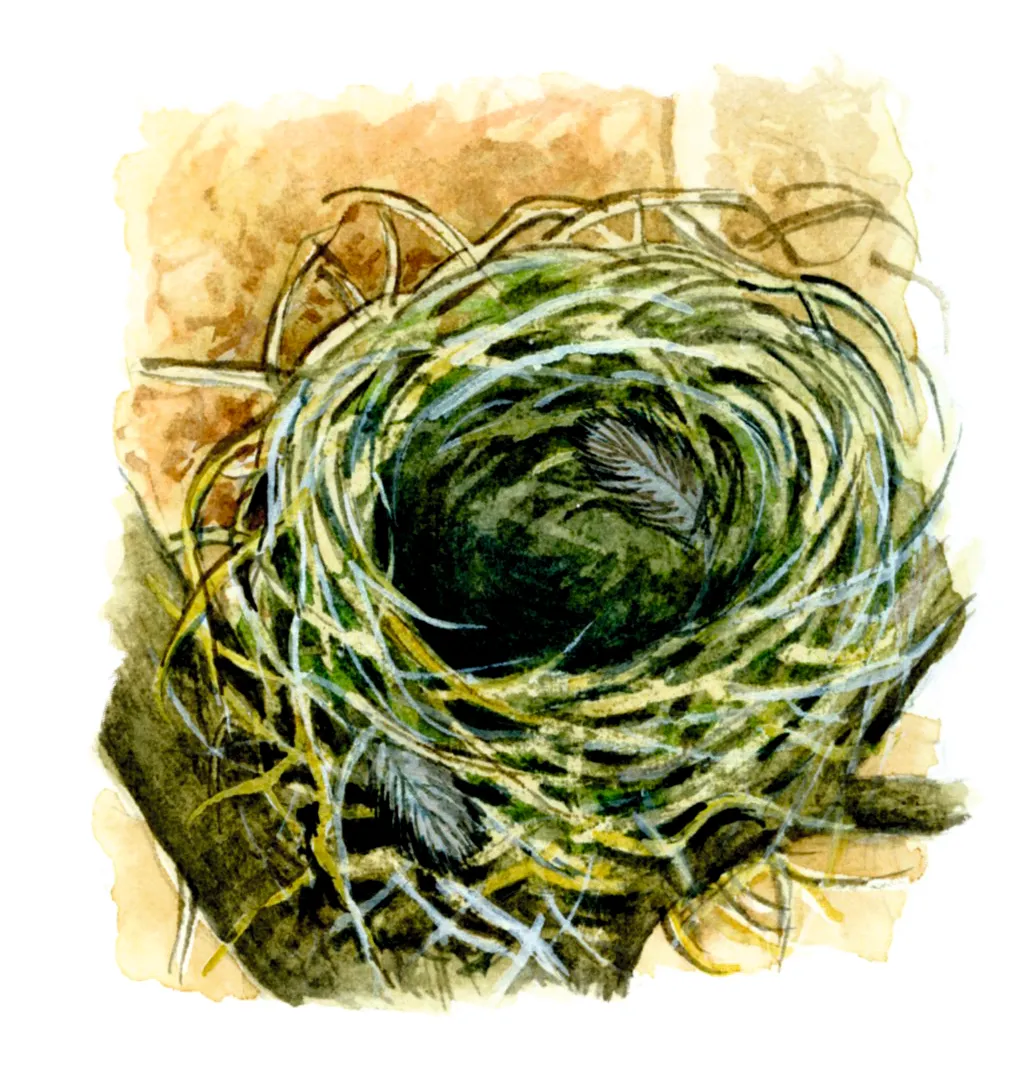
Eurasian reed warbler (Acrocephalus scirpaceus)
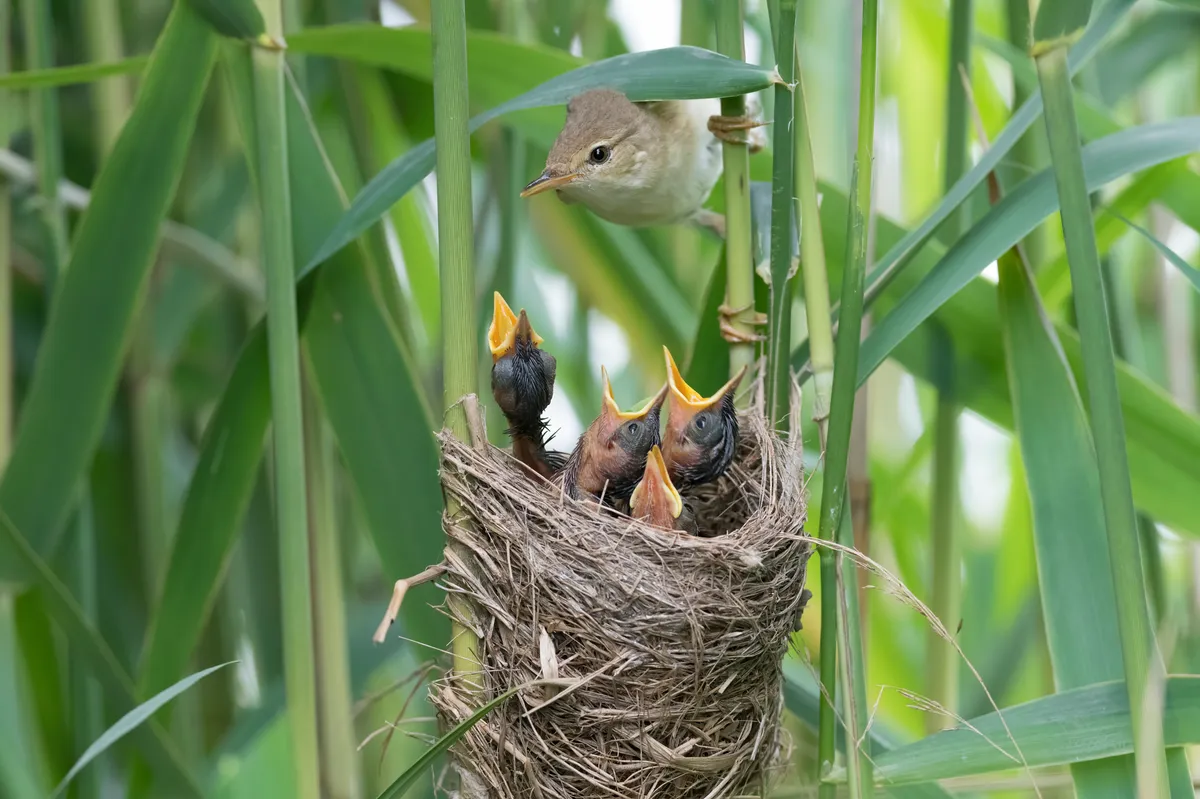
A reed warbler's nest is unlike any other British bird nest, it is cylindrical, with the cup 6-20cm deep. It is lined with reed flowers, grass, feathers or hair. It is usually found in the open 20-250cm above the ground, woven around several old and new reed stems. Occasionally other supports, such as willow, willowherb and loosestrife, are used.
Woodpigeon (Columba palumbus)
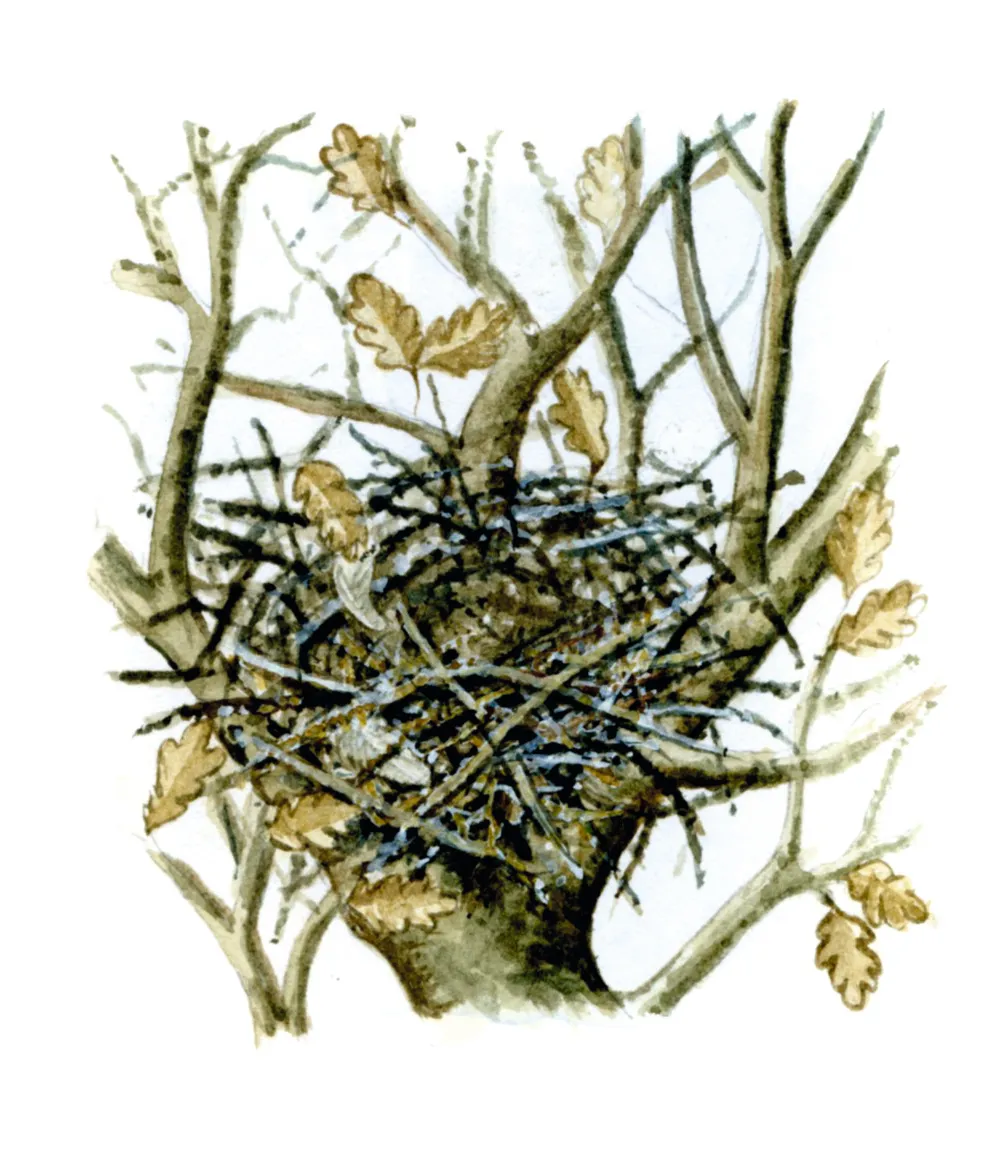
A woodpiegon's nest is a notoriously flimsy platform of twigs in trees or other similar platforms such as balconies, and is often see-through from below.
Magpie (Pica pica)
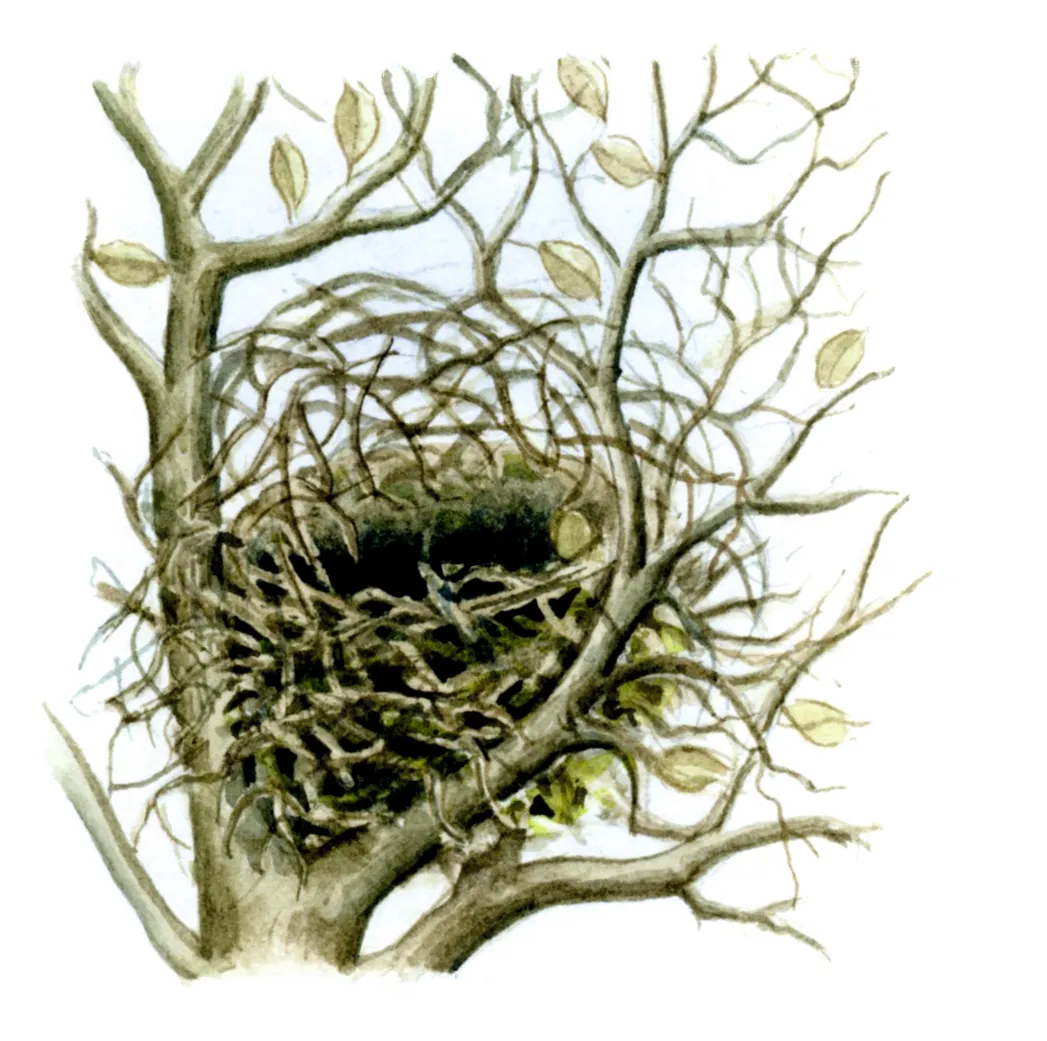
A magpie's nest is a superficially like squirrel drey but no leaves attached to twigs, it look like a mess of twigs with tell-tale ‘basket handle’ over the main structure. The bottom half lined with mud, whilst the upper half is open criss-cross ‘canopy’, using thorny twigs, so the two halves appear different. However this canopy is not always present, especially in thick cover. The nest is usually near the top of tree away from trunk and main branches, and often in isolated trees (unlike squirrels).
The magpie's scientific name, Pica pica, is an example of a tautonym, where the genus and specific name are the same.
Rook (Corvus frugilegus)
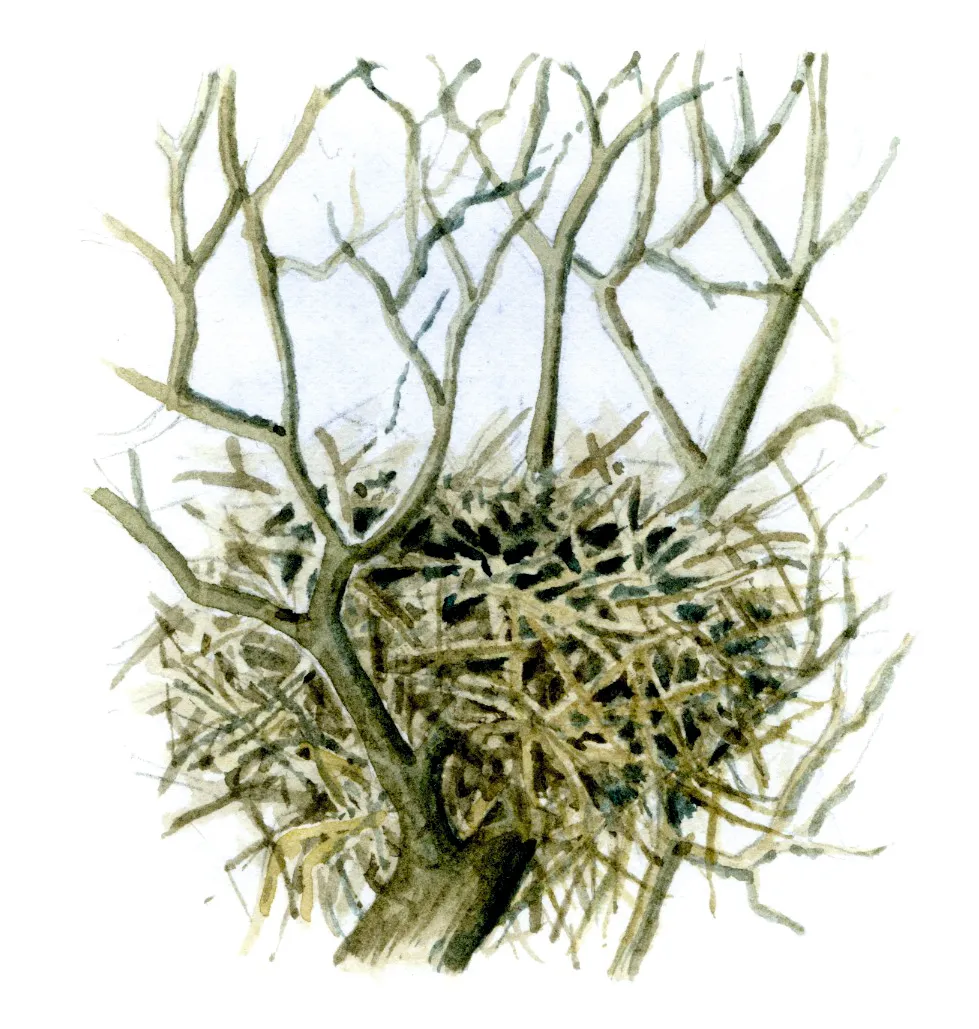
Rooks create large twig nests at the tops of trees, usually in small groups.
Sparrowhawk (Accipiter nisus)
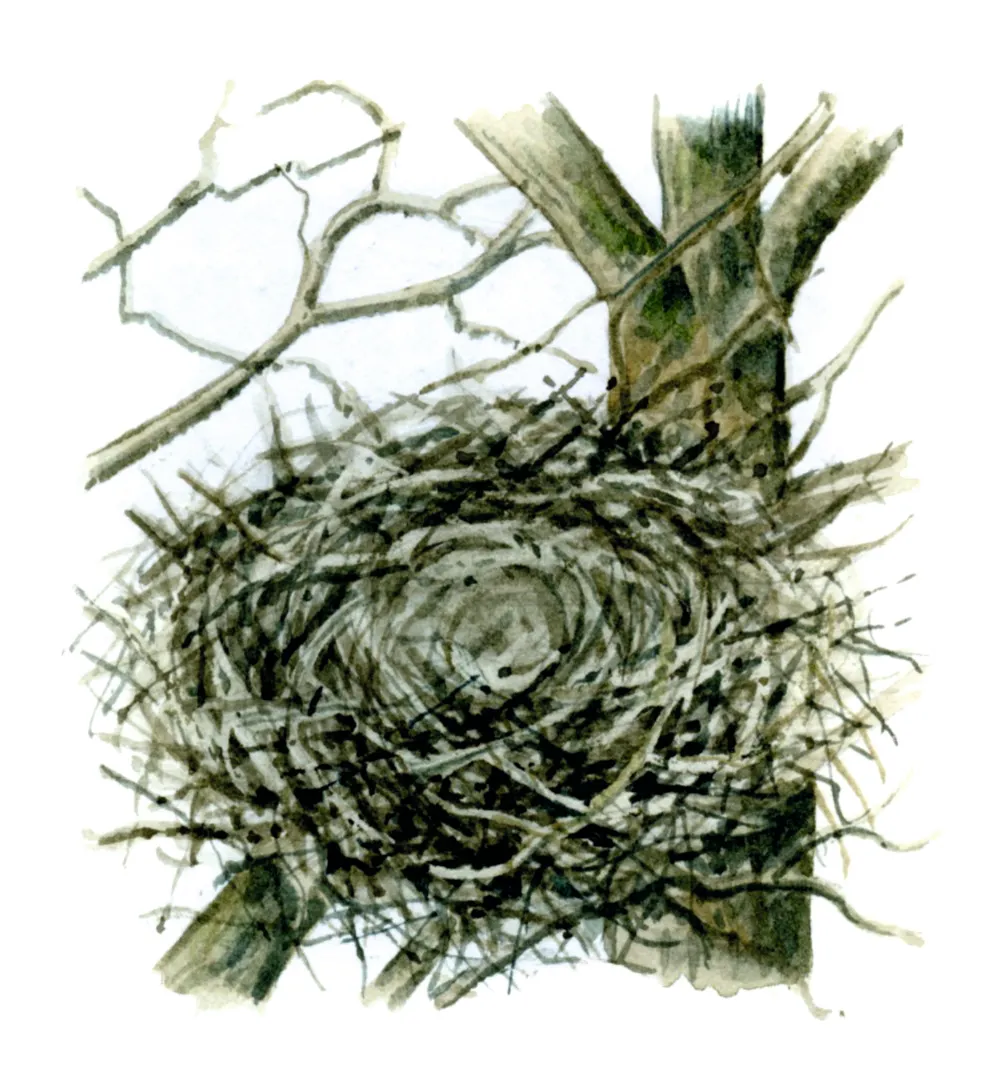
A sparrowhawk's nest is a usually flat, untidy platform of loose twigs with no leaves attached, with the twigs often laid all one way and trail down one side. Small feathers usually caught on twigs, and these are visible from the ground. The nest is often deep in a conifer tree, but also in deciduous trees, usually close to main trunk, but may be on horizontal bough. Prey remains can be seen under the nest.
How to identify empty mammal nests
Field vole (Microtus agrestis)
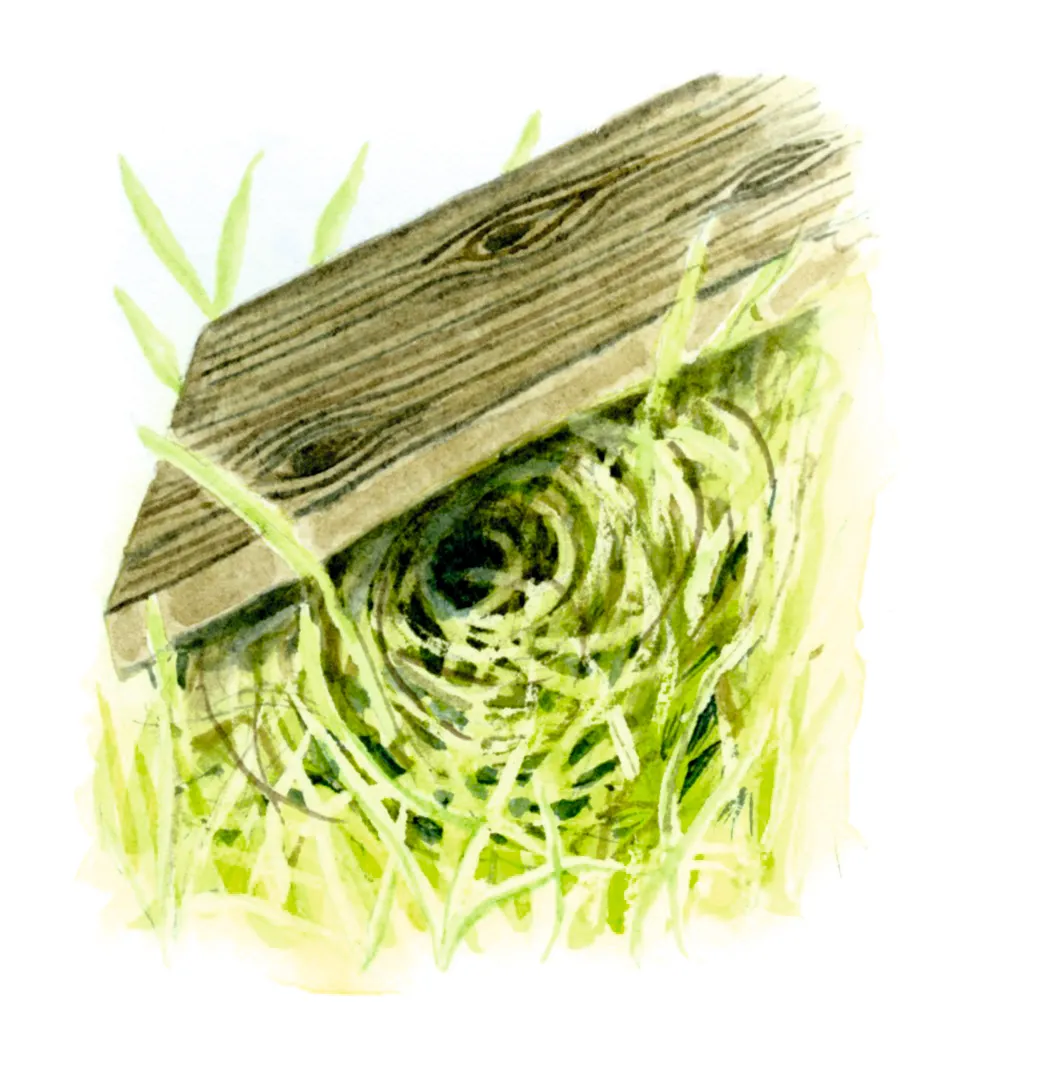
A field vole's nest is a ball of nibbled grass stems, often located under discarded planks.
Hedgehog (Erinaceus europaeus)
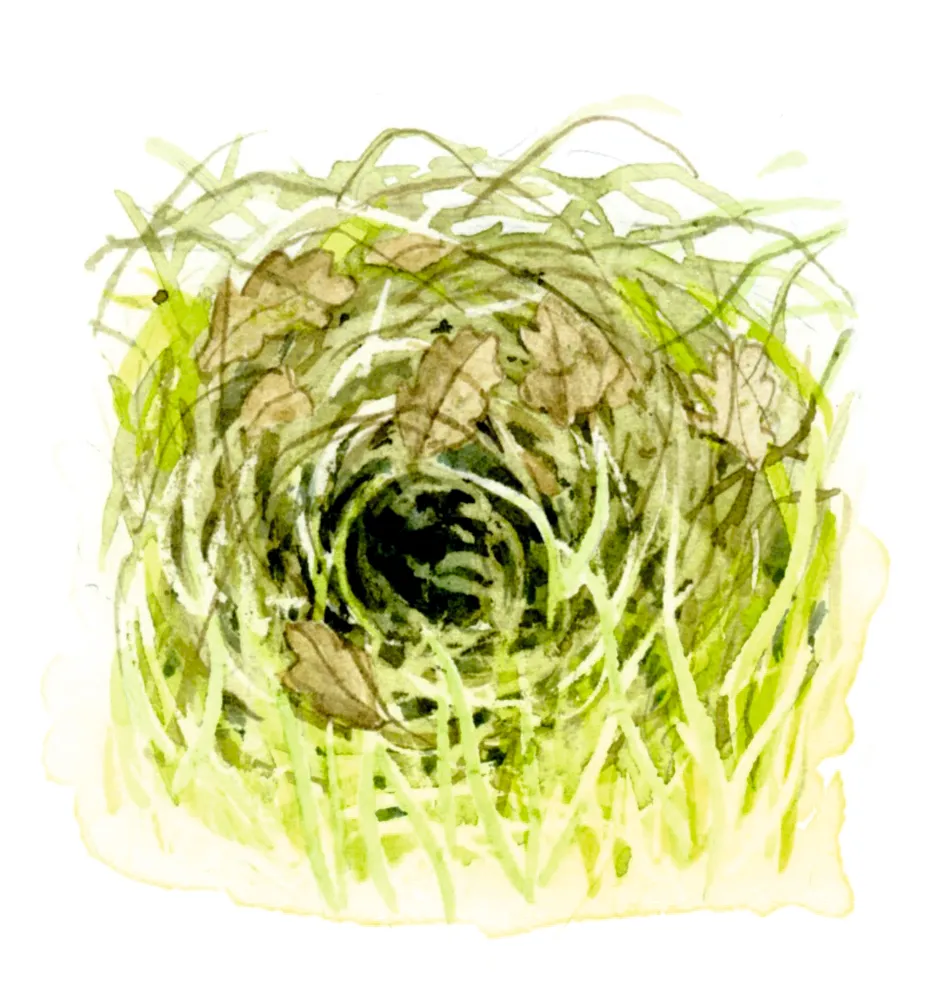
A hedgehog's nest can be found on the ground, usually well concealed under bushes, scrub, logs, sheds or rubbish. A hedgehog's flimsy summer nest is made of woven leaves and stems hidden in shrubs, and is dome-shaped, robust, 30-60cm in diameter. Hibernation nests often more substantial and in shallow depression so not protruding much above leaf litter, and is built of leaves, with walls tightly packed and braced against bushes or logs.
Harvest mouse (Micromys minutus)
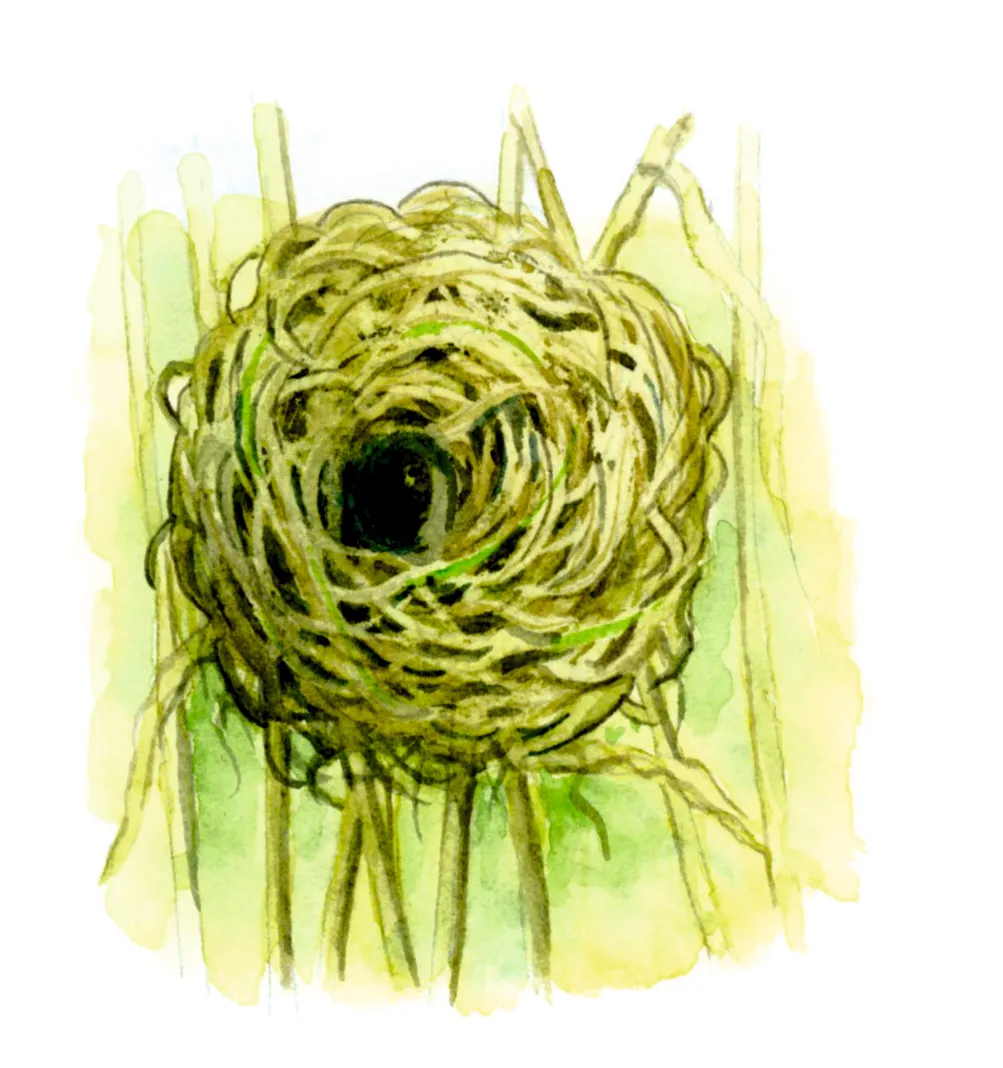
A harvest mouse is very distinctive and unmistakeable, as a neat ball built in stiff grass on verges, hedgerows, marshes or even over standing water. The nest can be up to cricket-ball size, made from living grass leaves that have been shredded longitudinally, but with outer leaves still attached to grass stems. The grass is still green when nest is in use. The nest hangs free, not wrapped around stems, 15-100cm off the ground.
Hazel dormouse (Muscardinus avellanarius)
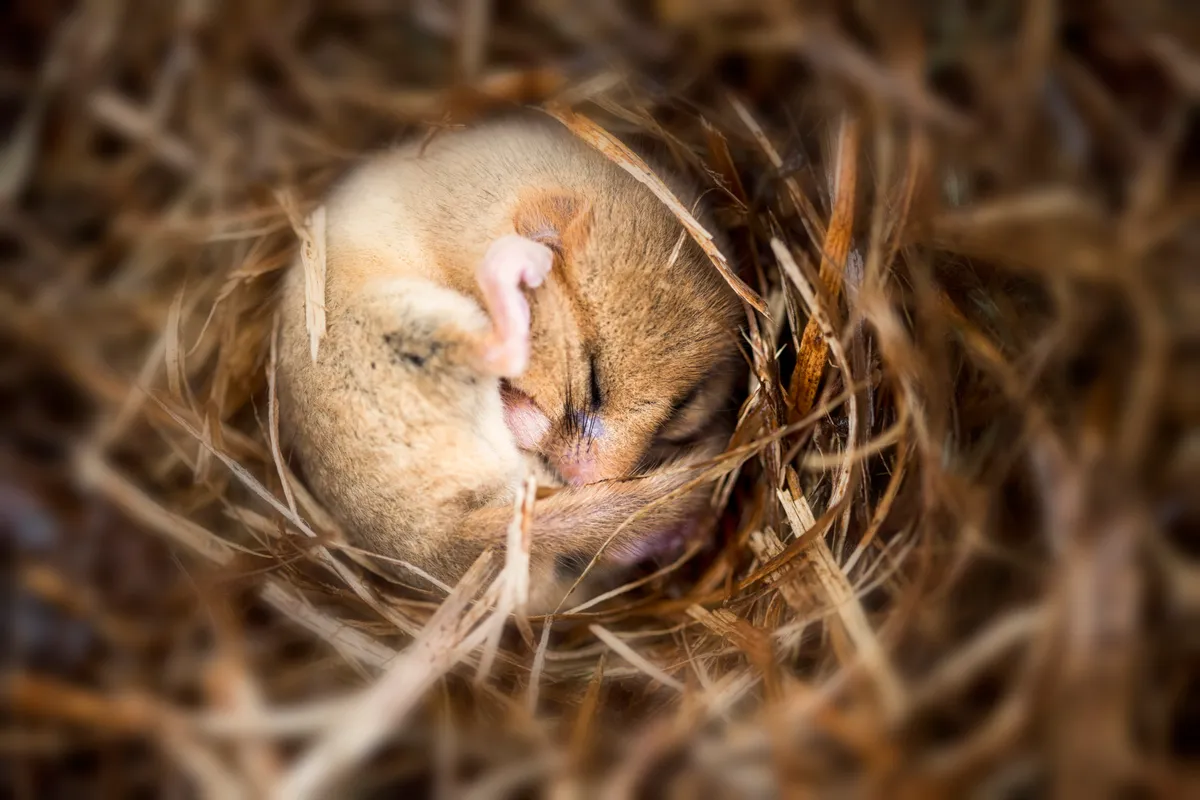
A hazel dormouse nest is grapefruit in size, and can be made entirely of honeysuckle bark but grasses, dicot leaves and moss also used.When grass is used, nest is not attached to grass stems and not shredded longitudinally as in harvest mouse.
It can be found in similar situations to a wren's nest; dense cover, bushes, climbing plants, bracken, gorse, and also frequently in hollow trees. However, unlike the wren’s nest, there is no obvious entrance hole, and a wren's nest is more variable in what it is made from.
Grey squirrel (Sciurus carolinensis)
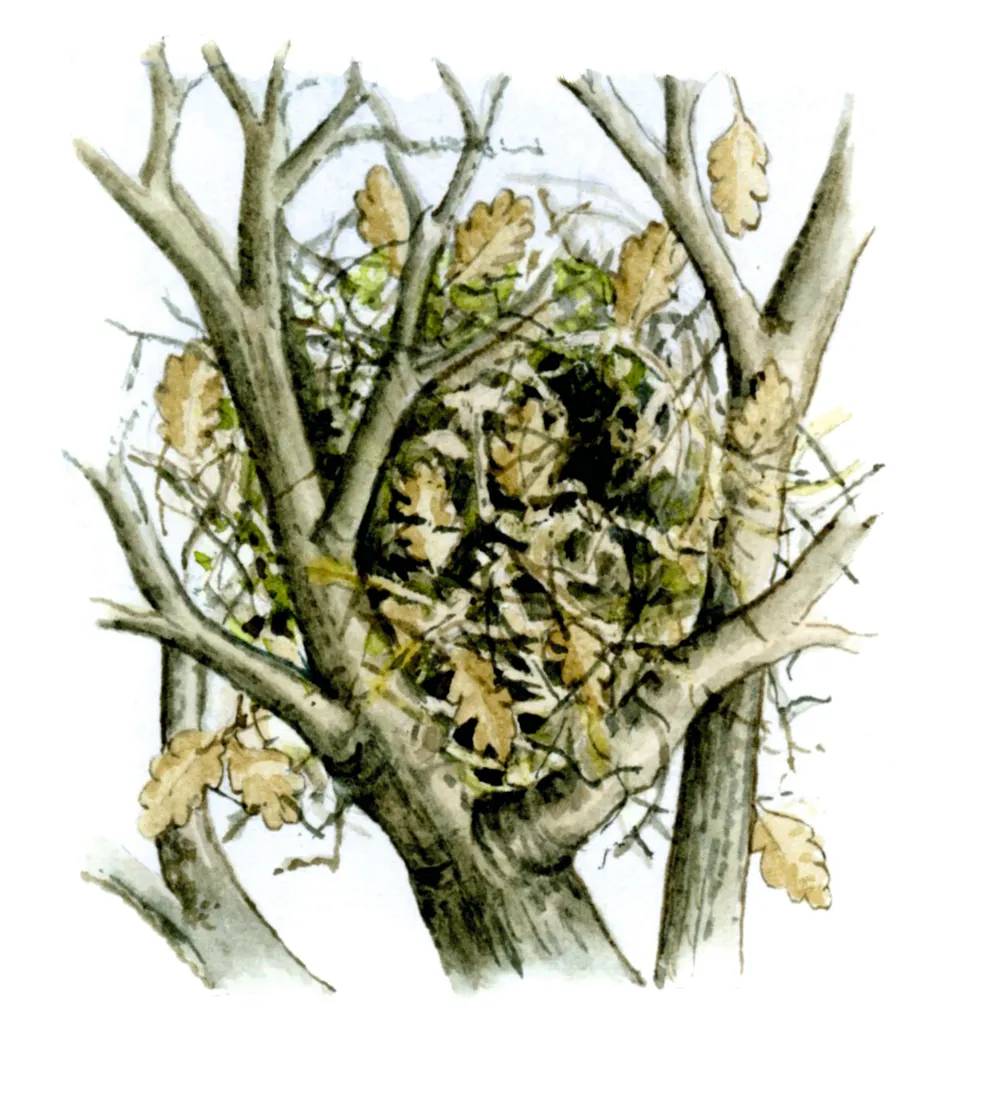
A grey squirrel's drey is a made of up a round plait of twigs, often with conifer needles, cones or dead leaves attached. It usually measures 30cm in diameter, but up to 50cm, close to tree trunks or forks in branches. It is impossible to tell red from grey squirrel drey. Squirrels also use holes in trees (often woodpecker’s), gnawed to 7-10cm in diameter. Dreys are more common in conifers because fewer tree holes are available.
Main image: Wren at the nest with food for the young. © David Barnes/500px/Getty